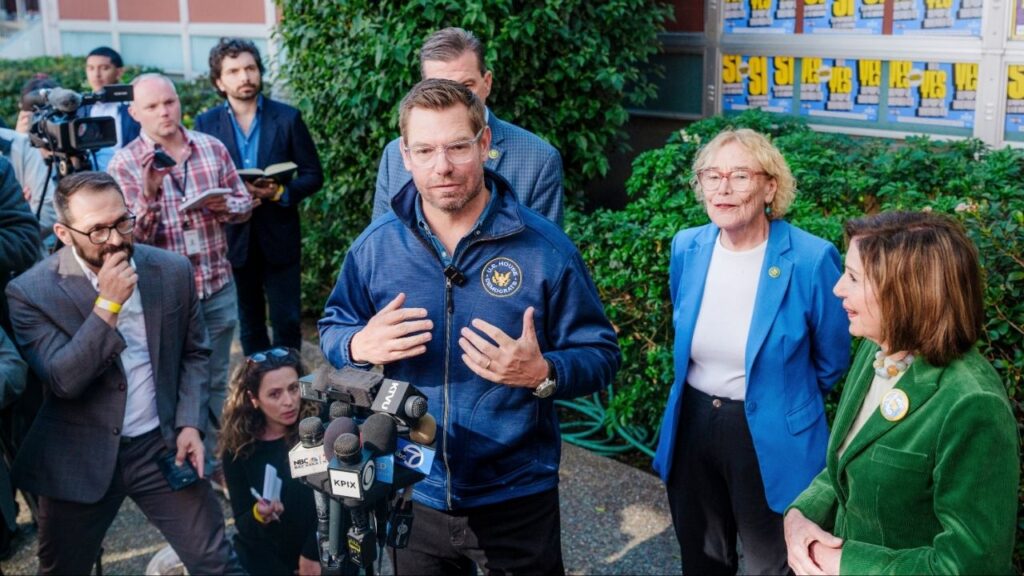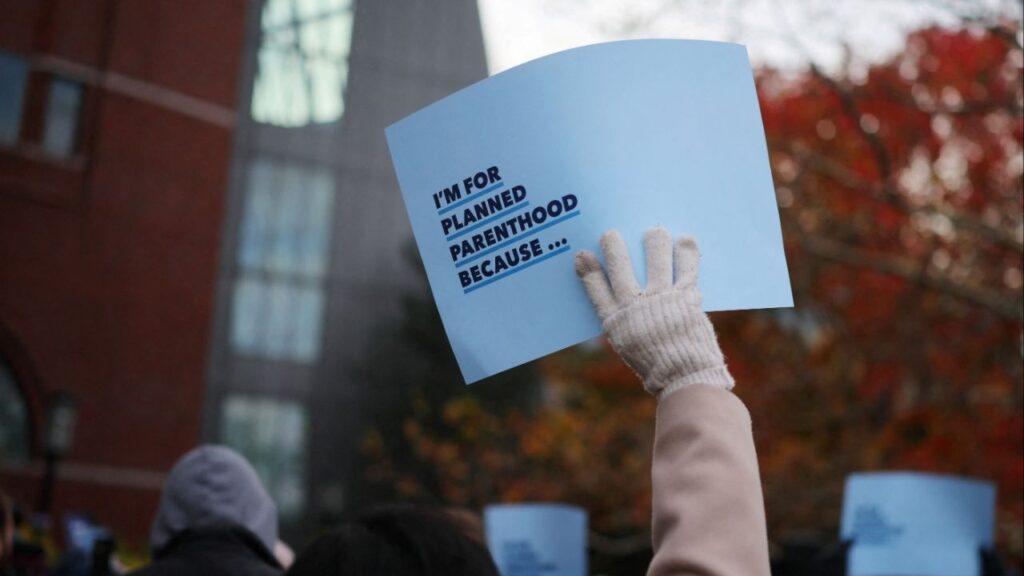Share
As 2018 was winding down, one of California’s leading newspapers suggested, via a front-page, banner-headlined article, that the drought that had plagued the state for much of this decade may be returning.
Just weeks later, that same newspaper was reporting that record-level midwinter storms were choking mountain passes with snow, rapidly filling reservoirs and causing serious local flooding.

Dan Walters
CALmatters
Neither was incorrect at the time, but their juxtaposition underscores the unpredictable nature of California’s water supply.
The fickleness of nature has been compounded by a decades-long, multi-front struggle among hundreds of water agencies and other interested parties over allocations of the precious liquid, not unlike the perpetual religious and ethnic wars that consumed medieval Europe.
Adding another layer of complexity, the conflicts over California’s water supply are often proxy wars for land-use disputes, involving such issues as whether the state’s chronic shortage of housing should be addressed by continuing to carve farmlands into subdivisions or shift to a high-density mode that builds up rather than out. Water supply is very often the decisive factor in land-use decisions, thanks to state laws requiring developers to prove they can obtain enough water to serve their projects.
Even though the state doesn’t seem to have a comprehensive approach to managing its water — although Gov. Gavin Newsom says he wants one — the big conflicts are deeply interconnected and appear to be reaching their climactic phases. How they are resolved over the next few years will write an entirely new chapter in California’s water history, changing priorities and perhaps shifting water from agriculture to urban users and environmental enhancement. But how that diversion will occur and how much water will be affected are very much up in the air.
- As Southern California’s population grows, it faces reduced supplies from the overused Colorado River, one of its main sources. The region’s water agencies want more water, or at least more reliable water, from Northern California.
- More Northern California water may depend on capturing and storing more during wet periods such as this past winter, and on boring at least one tunnel beneath the Sacramento-San Joaquin Delta to convey the water to the California Aqueduct that sends it south.
- Tunneling under the environmentally damaged Delta would deprive it of some water. State officials are pressuring California’s largest-in-the-nation agricultural sector to shore up flows through the Delta by reducing its use of San Joaquin River water.
- At the same time, those farmers also face new demands to reduce their pumping of underground water because overdrafting is causing land in the Central Valley to sink ominously.
California’s basic water infrastructure of dams, reservoirs, canals and pipelines was constructed in the 20th century. At that time, water supply was seen largely as an engineering problem: catching winter rains and spring snow runoff by damming rivers; moving water from its source to where it was needed for farms and homes via canals and pipelines; and drilling wells to augment surface diversions. The federal Bureau of Reclamation, the Army Corps of Engineers, the California Department of Water Resources and dozens of agricultural irrigation districts and city, county and regional water agencies built elements of the system.
The best known and most contentious—the inspiration for the movie “Chinatown”—was Los Angeles’ surreptitious acquisition of water rights in the Owens Valley, on the eastern slope of the Sierra Nevada range, and the draining of the valley to enable L.A.’s expansion into the country’s second-largest city.
However, just as the last of the state’s major water projects was completed in the 1960s, environmental consciousness arose, making what had been a linear exercise much more complicated. In the 1970s, new state and federal laws began compelling water managers to make allowances for the environmental effects of their diversions.
Meanwhile, California’s farmers opened vast new acreages of high-value crops, such as almonds, that demanded more reliable water. And the state’s population boomed to 40 million thirsty human beings.
During the first years of the 21st century, these and other trends coalesced into interrelated mega-issues that range the entire length of the state.
Divvying up the Colorado River
The west’s longest river touches seven states and forms the boundary between California and Arizona before flowing into Mexico and the Sea of Cortez. California has been legally entitled to 4.4 million acre-feet of Colorado River water, three-quarters of it for the Imperial Irrigation District in the state’s southeastern corner, which was among the river’s earliest diverters.
Historically, California drew more than its allotment. But Nevada and Arizona, with rapidly increasing populations, have sought more from the river. It is widely accepted that the Colorado simply cannot meet all demands, and after an extended drought, major reservoirs on the river, such as Lake Mead, are in danger of falling to unworkable levels.

The federal government stepped in, demanding that the affected states either voluntarily agree to reduce their draws or have Washington impose its own reallocation. Early this year, a short-term proposal was finally hammered out, but only after the Metropolitan Water District of Southern California agreed to provide most of the state’s reductions.
The Imperial Irrigation District was left out of the agreement after insisting that it would reduce its massive draw only if the federal government gave it $200 million to restore the rapidly shrinking Salton Sea, a saline inland lake created by an engineering mistake in 1905.
Without addressing the Salton Sea issue, a compromise Colorado River plan was approved by Congress and signed by President Donald Trump in April. With the short-term plan now in law, the affected states will turn to negotiating longer-term reductions in their use of the Colorado.
Whether those talks include Imperial and the Salton Sea remain uncertain. Responsibility for restoring the lake—if it can be restored—continue to ping-pong among federal, state and local agencies. Imperial is suing the Metropolitan Water District for leaving it and the Salton Sea issue out of California’s portion of the multistate agreement, saying that action violates environmental-impact laws.
Meanwhile, the deserts of southeastern California are seeing another sharp conflict over water, involving huge aquifers beneath the Mojave.
Cadiz, Inc., an investor-owned, publicly traded company based in Los Angeles, wants to extract about 16 billion gallons, or 50,000 acre-feet, of water a year from the aquifers beneath land it controls in the Cadiz Valley, midway between Barstow and Needles. It wants to sell the water to Southern California water agencies, saying it will relieve cutbacks in supplies from the Colorado River and Northern California.
The proposal has drawn fire from environmental groups, and efforts have been made in the Legislature to block it. But Trump’s administration has indirectly endorsed it by clearing the way for a pipeline to carry the water. The issue remains unresolved, however, and Trump’s support may even damage the project’s chances of ultimate approval.
The Storage Conundrum
More than 500 miles north of the Salton Sea, another big lake is being proposed: a reservoir on the west side of the Sacramento Valley that would, say its sponsors—both regional farmers and Southern California interests—ease California’s chronic shortage of water.
Building more storage, whether in reservoirs or by replenishing underground aquifers, is attracting more support as a response not only to drought but also to forecasts that climate change will cause California to receive more precipitation as rain and less as snow. That change would degrade the natural reservoir of winter snowpacks in the Sierra and other mountain ranges.
Sites Reservoir has been on the drawing boards of water managers for decades but now seems closer to reality. It would be an “off-stream” reservoir, similar in concept to the state-federal San Luis Reservoir in the Pacheco Pass west of Merced.
That is: As an alternative to damming, Sacramento River water would be pumped into Sites during high flows via a 14-mile-long pipeline—as much as 1.8 million acre-feet when full—and released back into the river as needed.
The idea has long been backed by agricultural interests. But most recently, Southern California’s Metropolitan Water District has weighed in with money to assist in its planning. The state is also a major booster, as is the federal Bureau of Reclamation.
The off-stream nature of Sites and the prolonged drought have reduced the traditional opposition of environmental groups to water-supply projects. So Sites stands a pretty good chance of becoming reality, although the $5.2 billion cost has not yet been fully covered.
Sites is not the only storage project kicking around, however. Agricultural groups south of the Delta, facing cutbacks in both surface and underground supplies, have been trying to gain traction for what’s called Temperance Flat, a dam on the San Joaquin River just upstream from the river’s major storage facility, Friant Dam and its Millerton Lake.
As an on-stream project involving an already stressed river, however, Temperance Flat is much more controversial than Sites and less likely to make the cut.
A third project is the enlargement of the Los Vaqueros Reservoir in Contra Costa County, which draws water out of the Delta. It enjoys support from environmental groups and, as an off-stream project, is likely to eventually receive state construction funds.
As these proposals make their way through the political and regulatory thickets, with no outcome certain, there is one more big project in the talking stage: raising Shasta Dam on the Sacramento River north of Redding, increasing storage in what is already the state’s largest reservoir, with a current capacity of 4.5 million acre-feet.
Although the idea of raising the dam by 18 feet and increasing Lake Shasta’s storage by 600,000 acre-feet has kicked around for decades, Washington has made the $1.3 billion project a priority as part of Trump’s pledge to help California farmers with water supplies.
It’s become one of dozens of conflicts between California and Trump. State officials, backed by environmental groups and Indian tribes, say the plan would destroy sacred tribal sites and violate the state’s Wild and Scenic Rivers Act protections for the McCloud River, one of the Sacramento River’s major tributaries.
The Bedeviled Delta
The Sacramento and San Joaquin Rivers, along with several lesser waterways, merge in the 1,100-square-mile Delta, originally a seasonal marsh. During the late 19th and early 20thcenturies, the Delta was transformed by human labor into a maze of agricultural islands separated by about 1,000 miles of channels and sloughs that flow toward San Francisco Bay.
State and federal water systems push water into the Delta from dams and reservoirs, principally Shasta and Oroville, then pull water from the southern edge of the Delta for shipment via canals to San Joaquin Valley farms and Southern California’s 20-plus million residents.
The pumps involved are so powerful that they grind up some small fish and can reverse flows in the Delta’s channels, adversely affecting wildlife habitat.
Bypassing the Delta has been a bedrock of this system for more than a half-century. But making it happen has bedeviled governors and other politicians, as well as managers of delivery systems south of the Delta.
When Jerry Brown became governor for the first time in 1975, he hoped to complete the project that his father, Pat Brown, had begun by digging a “peripheral canal” that would draw water from the Sacramento River upstream from the Delta, near the tiny town of Hood. The water would have been transported 43 miles around the Delta to the head of the California Aqueduct near Tracy.
Actually, portions of the canal were already being informally dug as a source of dirt for the construction of the adjacent Interstate 5 freeway between Sacramento and Stockton. These “borrow pits,” as they were called, still exist as elongated ponds used by farmers to water crops and livestock.
Although Brown devoted much of his first governorship to campaigns for reelection, president and U.S. senator, the peripheral canal was a high priority. After much arm-twisting, aided by pressure from Southern California water agencies, the Legislature authorized its construction.

However, two major interest groups, San Joaquin Valley farmers and environmental-protection advocates, remained opposed. Farmers thought it wouldn’t deliver enough water to justify its cost, while environmentalists worried that putting in the needed plumbing would make it easier to build new river-killing dams.
The farmers and environmentalists formed an odd-bedfellows alliance that challenged the project via a referendum on the 1982 state ballot. Voters rejected the peripheral canal, putting the bypass approach to the Delta’s problems on the shelf for more than two decades.
The Delta issue devolved into morass of political and legal conflicts. Federal judges became the de facto managers of the Delta’s waters, ordering cutbacks on pumping to protect fish.
The bypass approach reemerged during action-movie star Arnold Schwarzenegger’s improbable governorship, this time in the form of one or two tunnels beneath the Delta. A strategy was devised that would allow water agencies to bore the tunnels without direct authorization by the Legislature.
As Brown began his second governorship in 2011, succeeding Schwarzenegger, the planning process was well underway. Brown enthusiastically endorsed it, characterizing it as a way to save the Delta, and it acquired a new official name, “California WaterFix.”
By the time Brown departed again in 2019, however, the project’s fate was still uncertain. The huge Westlands Water District, which would be a major beneficiary, pulled out, saying, in essence, that it wasn’t worth the cost. Southern California’s Metropolitan Water District continued to push hard for its construction and pledged to meet much of the $14 billion price tag.
Very quickly, Brown’s successor, Gavin Newsom, changed course. Newsom had been skeptical of the tunnel project as lieutenant governor, and this month his Department of Water Resources formally abandoned the twin tunnels and relaunched the approval process for a single tunnel.
Whether one tunnel or two, WaterFix still faces daunting hurdles without a fixed timeline. Those include numerous regulatory and environmental reviews and a lack of commitment, so far, from the federal government to pick up some of its costs—even though Brown, as one of his last acts, negotiated a tentative deal to avoid outright opposition from the Trump administration.
A 300-Mile Flashpoint
If the Delta is the hydrologic flashpoint of California’s troubled water system, the 300-mile-long San Joaquin Valley—the heart of California’s huge agricultural industry—south of the Delta is its socioeconomic center.
As the Public Policy Institute of California puts it in one of its many water studies: “The valley is ground zero for many of California’s most difficult water management problems—including groundwater overdraft, drinking water contamination, and declines in habitat and native species.
When the region was settled in the latter half of the 19th century, its chief agricultural product was wheat. Eventually, that gave way to fruits and vegetables. Refrigerated rail cars made it feasible to ship fresh produce to eastern markets, and canneries captured some of the bounty.
Cotton also became a major crop in the southern portion of the valley. But as cotton acreage has faded, high-value crops such as almonds and wine grapes have emerged to dominate the region, along with dairies.
Post-wheat agriculture required irrigation water. One by one, the streams flowing into the valley from the Sierra were dammed by federal and local water agencies to capture winter rains and spring snow runoff with elaborate systems of canals to deliver water to the fields.
The California Aqueduct, which runs down the western edge of the valley, made it possible to sharply expand agricultural production there, much of it served by the nation’s largest irrigation district, Westlands. But the aqueduct became the focal point of political and legal conflicts that arose over the impact on the Delta, exacerbated by drought.
As state and federal water managers reduced allotments to valley farmers and federal judges required more water to remain in the Delta to protect endangered species, farmers drilled thousands of wells to keep their valuable orchards and vineyards alive. But the depletion of underground aquifers led to subsidence—shrinking or sinking land—that threatened the viability of the valley’s complex water-delivery system.
The most striking example is what happened to the Friant-Kern Canal, a 70-year-old project that moves water from Friant Dam on the San Joaquin River northeast of Fresno 152 miles to Kern County. Near Porterville, subsidence from overdrafting in Tulare County altered the canal’s slope and sharply reduced its capacity.
Overdrafts persuaded Brown and the Legislature to do something in 2014 that would have been unthinkable in the past: regulate groundwater. The law they enacted requires local water agencies to decrease pumping to sustainable levels.
Farmers backed an $8.9 billion bond issue on the 2018 ballot that included $750 million to fix the Friant-Kern Canal, but it was rejected by voters. Efforts are now being mounted in the Legislature to provide $400 million in state funds for repairs.
Subsidence has also exacerbated a San Joaquin Valley water-supply issue that carries a serious human health threat. Many small farming communities lack safe supplies due to pollution of their wells, even though the state has spent hundreds of millions of dollars on the problem.
Newsom is now proposing a dedicated tax on water and other agriculture-related activities to improve the substandard systems. But there’s obvious reluctance among legislators to tax such a basic commodity as water, and efforts are underway in the Capitol to find other kinds of funds.
As the groundwater issues play out, a high-stakes battle has been waged on the state Water Resources Control Board over whether farmers should reduce their use of San Joaquin River water so more could flow to the Delta for habitat improvement.
Farmers saw it as a tradeoff connected to the twin-tunnel project being pushed by Jerry Brown. They were being asked, they complained, to give up water for their fields and orchards so that more could be sent to Los Angeles.
The issue is still unsettled. Politically, the outcome may be connected to what happens to legislation to repair the Friant-Kern Canal.
If nothing else, the situation illustrates how the ostensibly separate conflicts over water storage, the Delta tunnels, Delta water flows, subsidence and groundwater regulation are, in fact, deeply intertwined.
So Where Are We Headed?
There are mismatches in California’s water supplies and uses. The most obvious one is that agriculture generates just 2% of California’s $2.6 trillion economy but consumes three times as much water as all other human activities.
Shifting a relatively tiny amount of water from agricultural to non-agricultural use, say 2 million acre-feet a year, could meet much of the demand from the latter. Many of the specific conflicts seem to be moving in that direction.
But how would such a shift occur?

One way would be to reconfigure California’s very complex welter of water-use rights, some dating back more than a century, that creates a pecking order for who gets water and who doesn’t, especially during droughts.
It’s why farmers north of Sacramento, with some of the oldest water rights, fare better than those south of the Delta, and why the Imperial Irrigation District has claimed ownership of most of the state’s Colorado River water.
Agricultural groups would resist diminution of water rights, seeing them as their last line of defense. But farmers, who once dominated the state’s politics, have also seen their political clout slipping away, so reconfiguring water rights could cause a major battle in the not-too-distant future.
Another way to shift water from farms to cities would be to expand what is now a relatively small water marketing system. Farmers and their water agencies have been trading water among themselves for decades, but only rarely have they sold water to non-agricultural users. A landmark example, which took many years, involved the Imperial Irrigation District and San Diego County’s water agency, which was seeking to become less dependent on Southern California’s Metropolitan Water District.
The fear among farmers is that however it may occur, shifting water from fields to cities will force them to take land out of production—“fallowing” in agricultural jargon—and further depress the industry’s status.
Environmental groups contend that rather than pursue new supplies of water, California should do a better job of using and conserving what it has by changing how farmers and homeowners use water to grow crops and lawns, spurring the change by pricing water more realistically, which could raise rates.
Southern California has reduced its per-capita uses of water over the last several decades as its population grew but its water supplies didn’t. But the big savings would have to come from agriculture because of its heavy use. In recent years, the shift to crops such as almonds has made farmers less able to cut back on water.
And then there’s desalination—tapping the unlimited waters of the Pacific Ocean by stripping away their salts.
One big desalination plant is operating in northern San Diego County, producing 50 million gallons of water daily, enough for 400,000 people, according to the San Diego County Water Authority. A clone is proposed in Huntington Beach, and Santa Barbara has a small plant for its own use.
The technology of desalination is well established. The problem is that the machinery consumes large amounts of electricity, which makes the output relatively expensive—about $2,000 an acre-foot. That’s close to what San Joaquin Valley farmers were willing to pay to keep their trees and vines alive during the drought a few years ago but only on a short-term basis. It’s a more acceptable price for households, which use about half an acre-foot a year.
During the state’s countless water policy conferences, some desalination advocates envision coupling huge arrays of solar panels with a string of coastal desalination plants to provide unlimited supplies of carbon-free water—and ending California’s water wars forever.
Is that a pipe dream? Possibly. But it may also be no more inconceivable than the world-class system of capturing and conveying water that transformed California from sparsely populated frontier into a state of 40 million people with the fifth-largest economy in the world.
CALmatters is a public interest journalism venture committed to explaining how California’s state Capitol works and why it matters. For more stories by Dan Walters, go to Commentary.



















